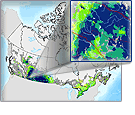Soil
Type of resources
Available actions
Topics
Keywords
Contact for the resource
Provided by
Years
Formats
Representation types
Update frequencies
status
Service types
Scale
Resolution
-

Soil Landscapes of Canada (SLC) derived from V3.1 and V2.2 – Cartographic 1M will provide a general overview of soil landscapes in Canada at a scale of 1: 1 Million.
-
The “Thematic Soil Maps of Manitoba” is a revised and condensed version of the Manitoba Detailed Soils Database produced by CANSIS. It contains data relating to the soils slope, drainage, agricultural capability, erosion potential, and surface texture.
-
The “Thematic Soil Maps of Saskatchewan” is a revised and condensed version of the Saskatchewan Detailed Soils Database produced by CANSIS. It contains data relating to the soils slope, drainage, agricultural capability, erosion potential, and surface texture.
-

The “Soils of Canada, Derived” national scale thematic datasets display the distribution and areal extent of soil attributes such as drainage, texture of parent material, kind of material, and classification of soils in terms of provincial Detailed Soil Surveys (DDS) polygons, Soil Landscape Polygons (SLCs), Soil Order and Great Group. The relief and associated slopes of the Canadian landscape are depicted on the local surface form thematic dataset. The purpose of the “Soils of Canada, Derived” series is to facilitate the cartographic display and basic queries of the Soil Landscapes of Canada at a national scale. For more detailed or sophisticated analysis, users should investigate the full “Soil Landscapes of Canada” product.
-

The “Soil Landscapes of Canada V.2.2/V.3.1 - Soil Order” displays the highest (most general) level of soil classification. Within the Canadian System of Soil Classification there are ten recognized soil orders (Soil Classification Working Group 1998). This system is hierarchical (from general to specific). Soil orders are further subdivided to great groups, subgroups, families, and series.
-
This dataset is aligned to a grid that with a dataset of soil attributes following GlobalSoilMap standards and specifications at specified depth increments extending over the agricultural portion of Canada. The SLC map polygons were rasterized and combined with the Shuttle Radar Topography Mission (SRTM) 90 metre grid to create the gridded raster dataset. Weighted averages of soil attribute properties are generated from existing soil horizon information to conform to recognized fixed depth increments. Soil attribute weighted means are calculated by using all the soil components based on their areal extent in each SLC polygon. The polygonal attribute weighted mean averages are spatially represented by the grid. For more information, visit: http://open.canada.ca/data/en/dataset/cb29b370-3639-4645-9ef9-b1ef131837b7
-

The National Ecological Framework for Canada's "Soil Texture by Ecoprovince” dataset contains tables that provide soil texture information within the ecoprovince framework polygon. It provides soil texture codes and their English and French language descriptions as well as the percentage of the polygon that the component occupies. Soil texture indicates the relative proportions of the various soil separates (sand, silt, clay) as described by classes of texture. Soil separates are mineral particles, 2.0 mm in diameter and include: gravel 0.2 -7.5 cm and cobbles 7.5-25.0 cm. There are 12 texture group classes definitions and one class definition for Not Applicable (which indicates, for example, water, ice or urban areas).
-
This service provides a map of the soil profile and soil body of Lithuania.
-
-

The 2006 Derived Interpolated Census of Agriculture by Soil Landscapes of Canada takes a subset of attributes from the 2006 Agricultural Census and creates new derived attributes that show the proportionate contribution of a variable to the total.
 Arctic SDI catalogue
Arctic SDI catalogue